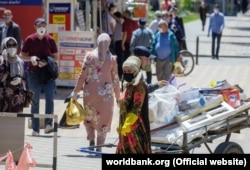Farrukh and his wife, Saodat, left their jobs at a village hospital in Tajikistan’s northern Sughd Province last summer and moved to Russia, taking advantage of a new government program that makes it easier for white-collar workers to live in the country and gain citizenship.
The couple, both doctors in their late 20s, now work at a district hospital in Russia’s Perm region, where the family has also been offered subsidized housing and financial aid.
At about $1,200 a month each, their salary is nearly four times higher than what they earned in Tajikistan.
“The quality of life is also much better here: We have running water and natural gas at home, and there’s no electricity rationing like in Tajikistan,” Farrukh said. “Food and utilities are cheaper here. My three cousins and their families also moved to Perm last year and work for private construction firms.”
Farrukh and his relatives are among the more than 3 million Tajik citizens who were officially registered in Russia in 2021, a record.
According to Russian Interior Ministry figures, 2,439,198 Tajik nationals stated “work” as their reason for entering Russia. That’s about one-quarter of Tajikistan’s entire population.
It’s a significant rise from previous years when the number of Tajiks working in Russia was reported at about 1.2 million. While seasonal workers make up the majority of the migrants, a growing number of Tajiks are looking for permanent resettlement in Russia.
That trend is widely expected to continue upward, as unemployment and poverty in Tajikistan and other Central Asian countries are forcing millions of people to look for jobs elsewhere.
It comes as Russia -- facing a demographic crisis and a workforce shortage -- has been relaxing its migration and citizenship requirements, especially for nationals from former Soviet republics.
Botirjon Shermuhammad, a Moscow-based migration lawyer, says that “we’ll see more people from Central Asia coming to Russia” both for temporary work and permanent resettlement in the foreseeable future.
“There are anti-migrant comments and warnings by some Russian politicians, but the government understands that economic growth is impossible to achieve without the migrants,” Shermuhammad said. “Russia’s population is declining, and Central Asia is a major foreign source for its workforce.”
Russia’s population shrank by nearly 1 million people in 2021, the largest peacetime decline ever. The stark drop was also linked to a high toll of COVID-19 deaths.
But Russia has been facing a steady decline in its population since the dissolution of the Soviet Union three decades ago, with experts blaming low birth rates and a drop in life expectancy for the decrease. One of President Vladimir Putin’s pledges during his 2018 reelection was to reverse the demographic crisis by the end of his term in 2024.
Even before the pandemic, the Finance Ministry predicted a 4 percent decline in Russia’s working population by 2035.
Brain Drain
In Tajikistan, authorities often downplay the number of Tajiks migrants working in Russia, putting it at around several hundred thousand.
For many Tajiks, labor migration to Russia has been a solution to many social, economic, and demographic problems. The majority of rural households in Tajikistan rely almost entirely on remittances from relatives working in Russia.
With Russia offering higher wages and better living standards, more Tajik doctors, teachers, and ordinary workers are likely to emigrate. Many are expected to resettle in Russia permanently.
The economy has always been struggling and jobs have always been hard to come by in Tajikistan, where the population -- unlike Russia -- has been rising rapidly over the past 30 years.
But Tajikistan is also slowly beginning to feel the downside of the migration -- a brain drain -- as skilled specialists leave the country.
Tajikistan doesn’t say how many medics, teachers, or other skilled workers have left the country.
On February 10, the health minister said there was a shortage of 674 medical doctors in “remote regions.” But amid the pandemic in 2020, Dushanbe acknowledged that the health-care sector was stretched thin, with a shortage of some 6,000 doctors and nurses across the country.
The Education Ministry said this month that there was a shortage of 1,124 qualified teachers, despite some 16,000 people graduating from teacher-training universities annually. It comes as 2,067 teachers from Tajikistan’s Khatlon Province alone moved to Russia last year.
With Russia offering higher wages and better living standards, more Tajik doctors, teachers, and ordinary workers are likely to emigrate. Many are expected to resettle in Russia permanently.
According to official Russian figures, 103,681 Tajik nationals obtained Russian citizenship last year. It’s a significant rise from five years ago, when about 30,000 Tajiks received Russian passports. Tajikistan allows dual Tajik-Russian citizenship.
Uzbekistan, Central Asia’s most populous country, continues to provide the highest number of workers for Russia.
In 2021, more than 4.9 million Uzbeks were registered in Russia and more than 4.5 million said they went to Russia for work.
More than 31,800 Uzbeks obtained Russian passports last year. Uzbekistan, a country of more than 35 million, doesn’t allow dual citizenship.

